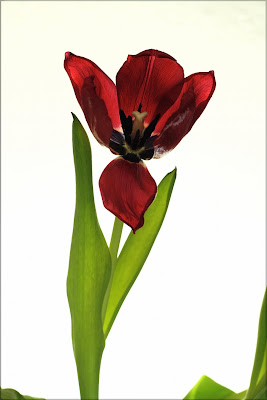
Here's a picture of a tulip or something. I could say that it represents the futility of life, that all things must come to an end, it is the yin and the yang, the alpha and the omega. Or I could just tell you that it's a flower that I photographed, and charge you £90 for a print.
Anyway, this is another shot from the legendary 1000D, and the image below demonstrates why it's a damn sight handier than a film camera. I spent an evening pissing about to get the picture above, and would have cranked through an entire roll of film to get one keeper:

Having said that, the film cameras do have a few advantages. Firstly, because they're full frame, my zoom lens actually goes wideangle. The 24mm prime doesn't even work on the digital camera, a fault of Sigma, not Canon. Second, the film bodies are Canon Eos 5's, which were designed as a weapon first and a camera body second. Each body was carved by hand from a block of magnesium alloy, before being individually field tested by the Marines under actual combat conditions. With a lens and external flash unit attached, the camera weighs about 30lb's, or at least it seems to after you've hiked more than 100 yards with it. Add to this the VG10 grip, which essentially converts testosterone into power, and you have a camera which defines manliness. More than one Reuters correspondent deflected a Scud missile with an Eos 5 during the first Gulf War.
The Eos 1000D is a somewhat different beast. As discussed, I no longer have to pay to get film scanned and developed. On a good day, a single 35mm frame would be scanned at 1232x1840 pixels, compared to the 1000D, which routinely produces images of 3888x2592, like 5 times the size. Which means bigger prints, which means that when you buggers start buying my prints you get more wall covered for your cash. It's also got more focus points than the Eos 5 (7 vs 5), on the other hand the Eos 5's AF points are eye controlled. This means you can focus on something just by looking at it through the viewfinder. This technology was subsequently used on the F117A Nighthawk. Mind you, I generally use the central focus point, then recompose, which explains why my wide aperture shots tend to be faintly out of focus.
Other things that are probably important: The Eos 5 has spot metering, while the 1000D doesn't. However, the Eos 1000D has 16 years of extra technological development behind it's metering system. Besides, if you shoot Raw you can pretty much not bother with exposure and fix it in post production.
So in summary:
Canon Eos 5
Pros:
- manly
- stealth technology
- cost of processing, developing and scanning
- waiting weeks or months to finish a roll because you have to value every shot
Pros:
- instant digital feedback
- Raw processing
- limited applicability as a tool of war
- no stealth technology (but still 16 years more R&D than the Eos 5 had)

5 comments:
Is Bronagh tearing out her hair at being a photographers widow, or patiently making 'that's great dear' noises and bringing you copious amounts of beverages? Nice pic btw, and I have that misty shot as my background :o)
I didn´t understand a word of this posting.
Catherine: Yes she is. She's doing both, which is pretty awesome. I'm glad you like the misty pic, I have it for sale as a print for £775, but so far no one is buying.
Alex: I'll draw you some pictures next time.
Do they really make Sponge Bob instruments?
They most certainly do, Mare:
http://www.musicroom.com/se/ID_No/0443907/details.html
Post a Comment